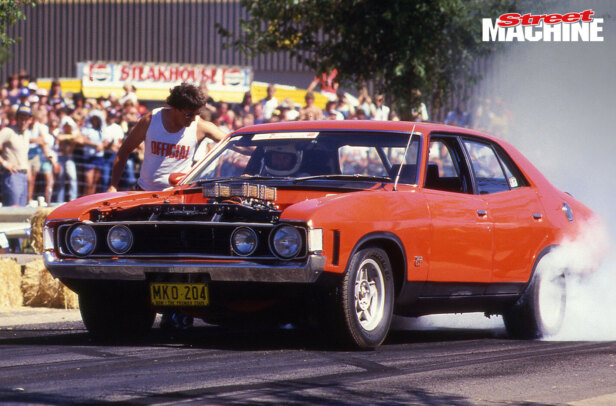Howard Astill doesn’t do daily drivers. He’s chiselled his name into the Aussie street machining hall of fame by turning out a string of revered Ford show cars over the past 40-ish years, so when Peter Lewis approached him for a new build, things could have easily not worked out. But they did, and we have this incredible, engineered-to-the-eyeballs XC Falcon showstopper as a result.
First published in the June 2023 issue of Street Machine
Peter spent a good chunk of his youth hooking around Broken Hill Speedway in LJ Toranas, with his first car, a blue six-cylinder XC Falcon, performing tow duties. So, when the time came for a new project a few decades later, the mining sector worker wanted to combine his first love with some of the best modern stuff money can buy.
“I’d done a lot of research on what I’d like in the build and had a list of things that were non-negotiable: XC, four-door, blue in colour, a Kaase Boss engine, six-speed auto, IRS and IFS, and it had to be able to be used as a daily driver,” Peter recounts. He kicked things off by purchasing a suitable Falcon as a tidy roller while working in Indonesia.
Buying parts for the build proved straightforward enough; finding the right guy to put it all together was trickier, so Peter got chatting with Paul Crossley at Anything Racing and Tim Bartrop (aka Dr Tim) to look at the practicalities of building and engineering his ultimate XC.
“Once we’d established the concept and theory that it could be done, it was a decision as to who could do the build,” he says. “Being a Broken Hill boy, I was aware that Howard Astill would be the obvious choice to do justice to the build, but I wasn’t certain if he could take it on, as he was deep into the Cobra 400 build.”
Peter admits he was slightly surprised when Howard expressed interest in the job, given he’d made it clear he doesn’t do street cars. “I knew that but didn’t want to say it out loud,” Peter laughs.
“I told him, ‘If you want me to build you a car, it’s gotta go to at least one show, maybe two’,” Howard adds.
With that point worked out, the XC headed to Astill Design. “It had been in a shop elsewhere and had the front and rear ends put in it,” Howard says. “But some of the direction [Peter] had moved on from. It had been sitting in storage for a few years, but he had a lot of the bits.” Most of the previous shop’s work was cut out, and the car was fully diced up.
“Early in the design phase, Howard mentioned what the theme could be,” Peter says. “A Ford designer could start with the XC body as a base, then walk out to the old and modern spare parts warehouses and decide what they would put in the car; basically a concept car built from a selection of old and new parts.”
BA Falcon bits were initially on the ‘modern’ menu, but as time progressed, FG gear became the hot ticket, which Howard describes as the build having a mind of its own. A complete FG floorpan and firewall were transplanted, alongside rear tubs and an all-new boot floor.
“All the FG functions except the airbags have been retained, including telescopic and height-adjustable steering, electric driver’s seat, and all the electronic features,” Howard says. That includes cruise control, ABS brakes, and just about anything else you could expect from a late-model Falcon. One hundred millimetres were sliced from the front edge of an FG dash, with the crash pad reshaped to mesh more neatly with XC design cues.
The front seats copped a similar re-forming, while the rear combines an XC upper with a reshaped FG lower, all by Elite Custom Interiors. The door trims are all custom, using FG inner handles and spears, and even the kick panels are FG and XC pieces hybridised via plastic welding and covered with black leather.
A Kaase Boss Nine mill was one of the earliest parts Peter grabbed, doing the deal at SEMA back when the Aussie dollar was still worth something. Swinging 429 cubes, it runs a Lunati forged rotating assembly for 9.8:1 compression and slurps 98 fuel through fly-by-wire stack EFI on a custom manifold. The tough combo spits out 773hp and 643ft-lb of torque.
A full suite of FG sensors keep tabs on everything from throttle position and knock detection to a/c and power steering pressure. It’s all ADR27A-compliant too, functioning as a sealed unit with an FG carbon canister and electronic purge system.
Given the sheer amount of late-model kit that’s been carried across, it makes sense that an FG ECU, BCM (body control module) and modified loom manage the whole thing. “Where wires needed to be extended, a second loom was used for parts so that all the colour codes were maintained,” Howard points out. Even the stock FG fuse boxes were retained for OEM functionality.
Precision Racing beefed up the ZF six-speed auto to tick off another of Peter’s non-negotiables, hooked up to the 429 with a custom converter and bellhousing.
The rear end is a seriously trick piece of gear in the form of a Kugel Komponents IRS assembly, which features a nine-inch centre and inboard Corvette-style brakes. The front end runs a Rod-tech IFS package paired to Commodore rack-and-pinion steering, with six-pot Brembo stoppers on Astill Design mounts.
Body mods are equally extensive, without sacrificing an iota of XC styling. The front arches were shifted to centre the wheels, which had moved forward due to the IFS, and the aluminium nosecone was deleted and replaced with steel extensions. The lower rear quarters were re-radiused, and the bumpers, bonnet height, rear window opening, B-pillars, and tail-light cut-outs were all reshaped, with exacting 4.5mm panel gaps set everywhere.
Other cunningly hidden touches include FG globes and holders filling the tail-lights, electric FG adjustment mechanisms hidden in the side mirrors, and a reverse camera tucked in the rear bumper.
“This has been the most complex build undertaken to date,” says Howard, “and has pushed us all to go above and beyond to get it to where it is now.” Within these pages, we can only really scratch the surface of the work involved in this car, so thankfully Howard’s published 75 videos (clocking in at over 26 hours) on his Astill Design YouTube channel to cover everything from Dr Tim’s torsion and beam testing process to zinc-plating the fittings.
Howard is basically part of the woodwork in the Summernats Elite Hall, though he admits even he missed a few (practically invisible to us regular folk) details in the “big picture” of getting the car to the ’Nats. “I wanted it there and presenting well,” Howard explains. “The judging almost became secondary.”
The XC still came away with some major tinware, including the coveted People’s Choice trophy and a Top 10 spot, plus Top Pro Touring and Top Interior. Podium finishes in Top Special Effects Paint, Top Bodywork and Top Undercarriage/ Driveline added to the haul, as did a Meguiar’s Superstars finalist spot at MotorEx 21.
Countless hours were sunk into polishing, detailing and adjusting the XC to reach the even tougher standard demanded by the MotorEx judging panel. It earned a Super Six finish, also placing in the Interior, Impact & Display and Overall Innovation categories.
With two of Australia’s most prestigious shows ticked off the list, Peter has well and truly fulfilled Howard’s ‘not just a daily driver’ request. “This car was built primarily as a car to be driven, and I think it reflects that, but by the same token, Peter’s got very little interest in the show scene,” Howard says.
BOSSXC is now done and will head to Peter’s home state of Queensland for a final tune and rego before hitting the road. Quite understandably, Peter’s got no plans for another project in the near future. “You always have to improve on the last project,” he says, “and I don’t think I could do that!”
Modern classic
It’s now a defining feature of the build, but the full FG fit-out wasn’t part of Peter and Howard’s earliest vision. While a set of FG seats and console went in early on, it was the ZF auto that spurred them to go all the way.
A transmission tunnel graft turned into a full floorpan swap, bringing the seat mounting points with it, and the FG firewall was shifted about 4in inboard from the XC’s original location. Not only does it look the part, but it also simplified the engineering process by retaining the modern car’s interior geometry.
PETER LEWIS
1977 FORD XC FALCON
| Paint: | PPG Vibrance Astill Deep Crystal Sapphire |
|---|---|
| ENGINE | |
| Type: | 429ci Kaase Boss Nine |
| ECU: | FG Falcon |
| Induction: | Kaase eight-stack EFI |
| Ignition: | MSD |
| Cooling: | Falcon radiator, Spal thermo fan |
| Exhaust: | Custom Astill Design, 2in primaries, four 2.5in pipes |
| TRANSMISSION | |
| Gearbox: | ZF six-speed auto |
| Diff: | Kugel Komponents IRS, 9in centre |
| SUSPENSION & BRAKES | |
| Front: | Rod-tech springs and shocks |
| Rear: | Kugel Komponents IRS and coil-overs |
| Brakes: | Brembo six-pot calipers and discs (f), Kugel Komponents inboard (r), FG ABS |
| Master cylinder: | FG Falcon |
| WHEELS & TYRES | |
| Rims: | Schott Mach V eXL Concave; 18×8 (f), 20×12 (r) |
| Rubber: | Michelin Pilot Sport; 265/35R18 (f), 335/30R20 (r) |
THANKS
Howard Astill and Darren Blackman for all the heavy lifting; Paul Crossley for mechanical and computer programming; Simon Judd for trim; Luke Demain for electrical; Phil Kerjean for performance plumbing; Steve Rotaman at Astill Design; Ben Ambrose for filler and primer; PPG staff led by John Hristias; Tim Bartrop for engineering; Dave Stephenson for the extra pair of hands; Adam & Kylie Perry for the finish-line help and detail.





Comments